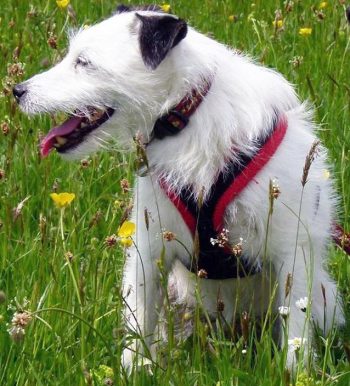15 Jan 2018
Amy Watson and Pete van Dongen discuss the benefits and suitability of choosing a non-restrictive harness.

An example of a non-restrictive dog harness.
In our work as veterinary surgeons and Canine Rehabilitation Institute-certified canine rehabilitation therapists, we see lots of dogs daily. Some wear dog harnesses, which, in general, we like. However, not all are the same – or, in fact, good – for your dog.
This article describes various types of harnesses and the reasons why they are more or less suitable for your dog.
The reason we like harnesses is they are ideal in a variety of situations, such as the following.
But when buying a harness for our dogs – or indeed advising our clients what to buy for their dogs – what should we be looking for?

It is critical a non-restrictive harness (examples pictured above) is used when exercising dogs – and by non-restrictive, we mean one that leaves the entire front leg free to move. The front leg of a dog is attached to the body purely by muscle and, when the dog moves, the front leg moves forward with some glide over the body wall, too (the faster a dog moves, the more glide occurs).
A non-restrictive harness allows for plenty of control over a dog, while still leaving its front legs free to move over their entire range of movement. This is particularly important for sporting and other working dogs.
A good, non-restrictive harness is one that fits snugly – you should just be able to place two fingers underneath the harness on all sides – and doesn’t cause any friction or excessive pressure. Some are fleece-lined and, therefore, very comfortable. Some harnesses also have D-rings at the front for an additional attachment of a (second) lead. This may give more directional control, in some circumstances.
A restrictive harness (see left), on the other hand, restricts the movement of the front limb – often by sitting over the shoulder joint, usually in the form of a straight band of the harness crossing in front of the dog. Sometimes, a strap is also positioned right under the axilla of both front legs.
This type of harness is problematic because it restricts the ability of a dog to move its front leg forward and, after a while, the dog altersits gait to restrict movement of the limb forward – even when not wearing the harness. This is bad for any dog, but especially so for performance dogs.
A restrictive harness also presses on the front of the shoulder where the biceps tendon runs, and some debate exists as to whether the increased pressure in this area may be acting as a factor in biceps tendon problems, such as bicipital tendonitis.
In addition, some restrictive harnesses have a strap across the back that presses on the back of the dog’s shoulder blade, also preventing the free movement of the front leg.
Research has demonstrated using a restrictive harness reduces stride length (or the step of your dog), and reduces the foot pressure by the dog. Interestingly, if the dog was pulling then the step length increased if it was wearing a restrictive harness. This may increase pressure on to the shoulder joints. The effect of a harness on a dog’s mobility is greater the more contact surface of the harness on the dog and the more often the dog wears the harness (Christine Zink, personal communication and Canine Sports Production).
Unfortunately, restrictive harnesses are often promoted for training and “all-day wear”, and often win awards in the dog literature for best harness or best new product, which isn’t helpful for the consumer or dogs wearing them. Another problem is a lot of working dog harnesses are restrictive – look at search and rescue dogs or police dogs that wear harnesses, for example. Even guide dogs wear restrictive harnesses. This is perhaps an area us rehabilitation vets need to tackle.
To summarise, if you are going to advise on a dog harness, make sure it is non-restrictive. Harnesses can be brilliant as long as the right one is used and it fits the dog correctly.